Subscribe to the Interacoustics Academy newsletter for updates and priority access to online events
Training in Pediatric Audiometry
-
dB A vs dB HL
-
Advances in behavioral testing
-
Pediatric Noise: Theoretical Introduction
-
How to Avoid Pitfalls in VRA Testing
-
Creating Visual Reinforcers for VRA Testing
-
Comparing Toy and Screen VRA Systems
-
VRA Testing: The Role of the Second Tester
-
Preparation and Setup for VRA Testing
-
Key Concepts in VRA Testing
-
Audiometría por observación de la conducta y audiometría por reforzamiento visual
-
Performing aided testing via Visual Reinforcement Audiometry
-
Performing visual reinforcement audiometry (VRA) with one tester
-
Play Audiometry: A Complete Guide
-
Perfecting your test technique: Visual reinforcement audiometry
-
Perfecting your test technique: Play audiometry
-
Challenges in Visual Reinforcement Audiometry
-
Play Audiometry with Speech-like Stimuli
-
Die Spielaudiometrie: Eine Anleitung
Visual Reinforcement Audiometry (VRA): A Complete Guide
Description
This guide provides a complete introduction to visual reinforcement audiometry (VRA) testing.
Table of contents
- What is visual reinforcement audiometry (VRA)?
- VRA transducers
- Stimuli selection
- Preparation and setup for VRA testing
- Choice of VRA system
- The role of the second tester
- Testing technique
- Recording responses: Using VRA ticksheets
- How to avoid pitfalls in VRA testing
- Results interpretation
- Aided VRA testing
What is visual reinforcement audiometry (VRA)?
Visual reinforcement audiometry (VRA) is a behavioral test of hearing best suited for infants from six months to around two and a half years of age. The aim of VRA is to identify minimum response levels at different frequencies to get information on the child's hearing.
VRA involves the child looking towards a visual target such as a toy or an image on a screen in response to a sound stimulus. If you’re using a toy, you should screen it from view of the child by smoked Perspex with the option to illuminate it when required to become visible.
An important aspect of VRA is the reinforcement element as the child sees the visual target each time they look towards it. But what exactly is being reinforced?
Principles of VRA testing
There are two main principles of VRA testing and it’s these that are reinforced by the presentation of the visual target.
1. Conditioning
The VRA response is a conditioned response. This means that the child associates the presentation of the sound stimulus with a reward. In this case, the visual target, which they receive upon performing a head turn towards that target. This concept of conditioning is the first principle.
2. Head turn towards the visual target
The second principle of VRA is that we must see that head turn towards the visual target. In some cases, you will hear this visual target described as a visual reward. But in fact, it’s a visual reinforcer because it serves the purpose of reinforcing the conditioned head‑turn response throughout testing.
VRA transducers
You can perform VRA using all available transducers:
- Headphones
- Free field speakers
- Insert earphones (via foam tips or the patient’s own earmolds)
- Bone conduction (can be performed on the standard hard band or using a soft band)
You can also perform VRA in the aided condition with the patient’s amplification (hearing aid or cochlear implant) in situ and switched on, to establish aided benefit and/or access to speech sounds.
Typically, VRA is initially performed via free field speaker presentation unless the patient has performed the test before and is tolerant of the different transducers. This allows for testing to be performed without risking the child growing upset if transducers are introduced.
It is important to be aware that free field testing is not ear specific. Even if stimuli are presented from the speaker to one side of the child or the other, responses cannot be deemed to be ear specific and individual ear testing is required to establish the hearing levels in each ear.
You can use insert earphones via foam tips or coupled to the patient’s own earmolds (if available and a good fit). For some children, it may be preferable to insert only one earphone at a time to assist with compliance.
Bone conduction testing is also not ear specific. The application of masking noise to the non-test ear is required to establish ear-specific bone conduction hearing levels.
Stimuli selection
You can use a range of stimuli for VRA testing, including:
- Warbles
- PED noise
- Narrowband noise
- Frequency-filtered sounds
You can use pure tones via headphones, insert earphones or bone conductors but not in the free field due to standing waves. Warble tones are typically preferred over pure tones as warble tones are more interesting to the child and more likely to capture their attention.
You can use narrowband noise if warble tones are not effective. However, narrowband noise lacks frequency specificity and risks off-frequency listening. A more frequency-specific option is PED noise.
A range of frequency-filtered sounds are available on the Equinox Evo audiometer. These can help capture the patient’s interest and attention if traditional stimuli are not effective. These are also suitable for aided testing.
Included in the Equinox Evo audiometer are the LING-6 sounds, the ManU-IRU stimuli, and the HD-sounds. These three sets of stimuli are also available on the Interacoustics Eclipse for aided cortical testing, allowing for continuity of test results across different age groups/stages and test types.
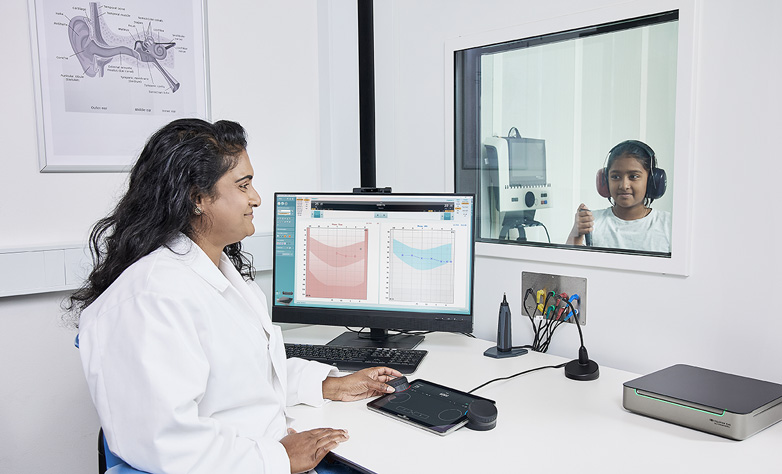
Preparation and setup for VRA testing
There are some specific considerations for the setup and preparation of VRA. We will explore how to ensure the appropriate test environment, how to furnish the clinic room, and how to prepare the different people involved in the test.
Test environment
Having an appropriate and dedicated testing environment is conducive to being able to perform high‑quality VRA.
Room size
The testing room should be large enough to accommodate:
- Both testers
- The child and their parent
- Required equipment and furniture
The British Society of Audiology recommends floor dimensions that are at least six by four meters.
Ventilation
The room should be well ventilated with adjustable air conditioning to ensure the comfort of the child.
Lighting
Adjustable lighting is important in case you need more illumination of the visual reinforcers to assist in testing of children with visual impairments. Downlighting is ideal to avoid casting distracting shadows (Figure 2).
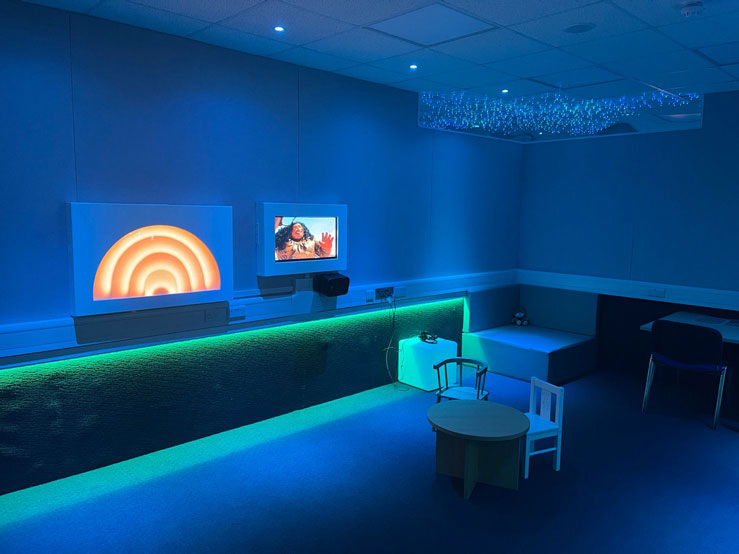
Soundproofing
The testing room should have adequate soundproofing for sound field testing.
Environmental sounds
You should avoid distracting environmental sounds. Suggestions include:
- Toys which make minimal noise
- Using a soft, wipeable covering to the table
- As few accompanying family members as possible
- Fit computers within the testing room with silent fans
- Avoid any siblings who may make noise and be distracting
Test room arrangement
Although many test room arrangements are used, the preferred setup is to use an observation room for testing. Tester one would be stationed in the observation room with the audiometer and VRA system controls. It’s vital that tester one has full observation of the child, second tester, and preferably the parents as well via a one-way window or camera image. Neither option should provide any form of distraction to the child.
Two-way communication
With a two-tester setup as the recommended best practice for VRA, it is important to have an effective two-way communication system between both clinicians. This is essential so that any necessary changes in test strategy or decisions regarding the accuracy of a head turn response can be discussed.
It is also important that the second tester can hear the stimuli presented to the child. This is necessary to identify whether a response is a true, time-locked response or a false positive “checking” response.
In a one-room scenario, the clinicians are easily able to speak with each other. However, the second tester will require a headset to allow them to hear the monitor function of the audiometer to know when the stimuli are being presented.
In a two-room scenario, a two-way communication system which allows both clinicians to talk to and hear one another is required. A wired headset device that operates via the audiometer (such as the Equinox Evo) is recommended to make use of the assistant / monitor functionality, which allows tester two to hear the stimuli presented.
Other systems that you can use include Bluetooth earpieces, hearing aids using the telecoil program, and baby monitor devices. However, these do not benefit from the assistant / monitor functionality within the audiometer.
Distraction-free
The testing environment should be as tidy and distraction-free as possible to keep the child focused on the important elements of the test, the visual reinforcers, and the second tester with engagement toys.
Furnishing the clinic room
Now that we have our room requirements, we can go ahead and furnish the room.
Patient positioning
It’s advisable to place a mark in the middle of the room where you want the patient to be sitting for testing. This should be where the sound field system has been calibrated to.
Sound field speakers
You should position your sound field speakers one meter from the patient at 90 degrees azimuth. It’s important to avoid any reflective surfaces near or around the speakers.
Visual reinforcers
You should position the visual reinforcers as close as possible to the speakers and in line with the patient's head. This will elicit the strongest and clearest head turn and help with ongoing reinforcement. In the youngest VRA patients or in case there are any issues with vision development, a nice option to have available is the ability to move the reinforcers closer to the patient. Mounting the reinforcers on movable brackets or a stand with wheels are two good options here.
Arrangement of transducer cables
With the audiometer being in a separate room, it will be necessary to patch transducer cables through to the main testing room. It’s a good idea to label the different ports to avoid any incorrect connections. Extra‑long transducer cables are also important so you can position them out of reach and out of the patient’s view as much as possible.
Seating considerations
Next, we need a low table of a suitable height for a child. In an ideal world, the table height should be adjustable to remain comfortable for different seating types and children of different heights.
A horseshoe shaped table with the child seated in the gap in the center has the advantage of wrapping around the child. Combined with a good choice of chair, this can help encourage the child to stay seated in the correct location.
A soft table covering can help reduce unwanted noise from any engagement toys that might get tapped on the table.
We also need to seat the child on a chair. It’s good to have a seating option for the parent if the child is going to sit on their lap for testing. However, the first preference should be for the child to sit on their own chair. This minimizes the risk of cueing from the parents which can be hard to detect.
A small captain's chair offers the same advantage as the horseshoe table by wrapping around the child. It can help to keep them seated in position and should be as close to the table as possible, preferably with the arms resting underneath for most benefit.
Another great option to have available is a highchair. This is something most children of VRA age will be familiar with and comes with the benefit of straps to help keep the child in place. If a standalone highchair isn't an option, it’s also possible to get small booster chairs which you can strap to a typical adult chair. Some come with their own tray table which the second tester can then place engagement toys on.
Engagement toys
Now that we have all our equipment and furniture in place, we need a plentiful supply of engagement toys. It's a wise idea to keep these in a box that you can hide out of view behind or under the table. A lid can also help to keep these out of sight.
To learn more about types of toys suitable for VRA, toy storage, and how to organize your toys, access this deep dive on toys for VRA and play audiometry.
People involved in the test
The final piece of preparation relates to the people involved in the test. Let’s say we have a scenario with our two testers, our patient, their parents, and a sibling who has joined the family for the appointment.
Number of people
The first recommendation in this scenario would be to ask one of the parents to take the sibling out of the room during testing. It's understandable that both parents would want to be present for the appointment. However, to reduce distractions, it would be best to ask them to leave and rejoin after testing.
Instructing the parent
You need to instruct the parent who remains in the room with the child. It’s important to explain the test to them in easy‑to‑understand terms. If the child is sitting on their own chair, the parent must stay quiet and still throughout testing, ideally situated behind the child.
The child can detect even small movements, so instruct the parent to help them avoid cueing or distracting. Both testers should remain vigilant throughout testing on the possibility of parental cueing.
If the child sits on the parent's lap for the test, instruct the parent not to react to the stimulus or the reward. In certain cases, you can encourage the parent to provide supplementary social reinforcement. The parent should support the child around the waist and under their arms, holding them upright and with a gap between them and the child. It’s important that the child remains alert throughout testing and is not tempted to relax back against the parent.
Ensuring cooperation from the patient
The patient's ideal state should be:
- Well rested
- Not hungry
- Not thirsty
- Not in need of a diaper change
The cooperation of the patient is essential to the success of a VRA session. Thus, avoid any possible sources of upset, need, or distress where possible. When booking the appointment, it’s worth asking if there is a good time of day. Avoiding nap times is always advisable.
Asking the parents ahead of time or at the start of the appointment about any preferences the child may have in terms of toys or visual reinforcers can give you useful information. Likewise, if the child has any aversions, it can be helpful to be aware of these.
It’s advisable to start testing when the patient is in the best state. If they are particularly shy, it may be worth spending more time to allow tester two to build up a rapport and engage the child in the session. If they are very active or appear to have a short attention span, testing as soon as possible may be the best course of action. You can always complete a full thorough history after testing.
It’s also worth judging whether to perform otoscopy, tympanometry, and OAE testing before VRA testing or whether to leave it until afterwards. Any procedure that may upset the child can risk losing their compliance and cooperation for the VRA test itself.
Choice of VRA system
One of the most exciting advances in the world of VRA has been the introduction of alternative methods of delivering visual reinforcement.
Traditional VRA systems
The original and classic VRA system involves using a box or series of boxes containing a puppet or toy (Figure 3).
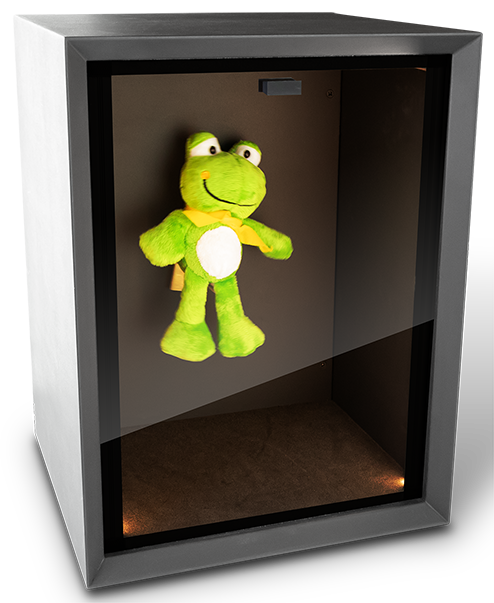
This toy is screened behind smoked Perspex to make it invisible to the child in the clinic room. The tester has a switch, button, or foot pedal to illuminate the toy when required. The most advanced of these systems also have the option to animate the toy to make it more stimulating and rewarding to the child.
Drawbacks to toy VRA systems
There were and are some drawbacks to the toy VRA systems.
1. Limited selection of toys
Each system generally has a limited selection of one to three toys available, which can lose their effectiveness as the test duration goes on and the child grows used to seeing the same reinforcers each time.
2. Not interesting to older children
Toys are generally very effective for the younger end of the VRA age range but are often not interesting enough to older children and for those with complex needs. Some clinics began to incorporate other forms of visual reinforcers such as flashing or spinning lights.
3. Old-fashioned
As the technological world has advanced and there is an increased number of screens accessible to young children through smartphones, tablets, and television, the toy system has begun to appear somewhat old‑fashioned. Many parents say that their children are more responsive to television and favored cartoons.
PC-based VRA systems
In recent years, visual reinforcer systems have emerged that meet the needs of a modern, screen‑motivated child. Some early examples were quite basic, homemade systems. But these have now evolved into user‑friendly devices perfect for clinical use such as the VRA Screen (Figure 4) and VRA Pure solutions from Interacoustics.
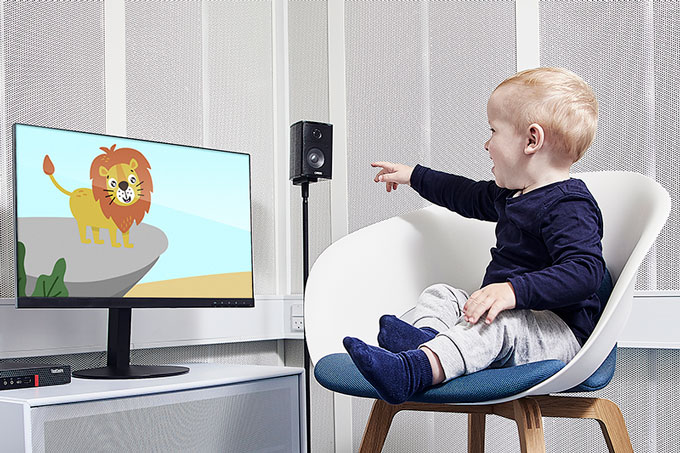
A digital screen system typically involves software loaded onto either your audiometer PC or a standalone PC. The benefit of a standalone VRA PC is that it can work with a standalone audiometer or alongside a PC‑based audiometer, making it a very flexible solution.
TV or computer screens are used to display the visual reinforcer to the child via a control system such as a mouse or a keyboard. Digital VRA systems can also work alongside toy systems to provide both options as available reinforcers, which is useful in case certain children prefer and respond better to one type over the other.
Benefits of screen VRA systems
Screen VRA systems offer a wider selection of reinforcers, including the ability to create your own.
1. Selection of reinforcers
One of the advantages of using a digital screen VRA solution is the option to use both still and static images as well as moving video files.
2. Create custom reinforcers
By far the most exciting advancement in the field of VRA – made possible by screen VRA systems – is the option to customize the visual reinforcers. This allows almost endless possibilities as well as the opportunity to tailor the reinforcers used to the child's particular interests and motivations.
Read also: Creating Visual Reinforcers for VRA Testing
3. Random playlists
The Playlist Creator software – which is available with VRA Screen and VRA Pure – allows you to create random playlists (Figure 5), where you can mix up all the different types of visual reinforcers, such as:
- 3D models
- Still images
- Moving videos
- Homemade videos
- High-contrast images
- High-contrast animations
This can become part of the game where the engager is talking to the child and going “what's going to come next?” “Who's going to appear on the screen next?” That can be quite exciting because it's a different type of image every time.

Integrated VRA systems
With the above-mentioned traditional and PC-based VRA systems, the main components are separate entities.
Traditional VRA systems require a standalone or PC-based audiometer and separate reinforcement system, which you control manually. PC-based VRA systems require a separate PC or the PC upon which the audiometer is installed.
Having separate systems requires the clinician to multi-task between the different controls, which can be challenging and distracting during a test that requires attention to be focused on:
- The patient
- Test strategy
- The second tester
- Clinical decision making
With its pediatric test module, the Equinox Evo audiometer combines both audiometer controls and visual reinforcement controls into one system. You can access the pediatric test module via the PC-based suite or the separate wireless Touch Keyboard, giving you full control over the testing process from one consolidated system (Figure 6).
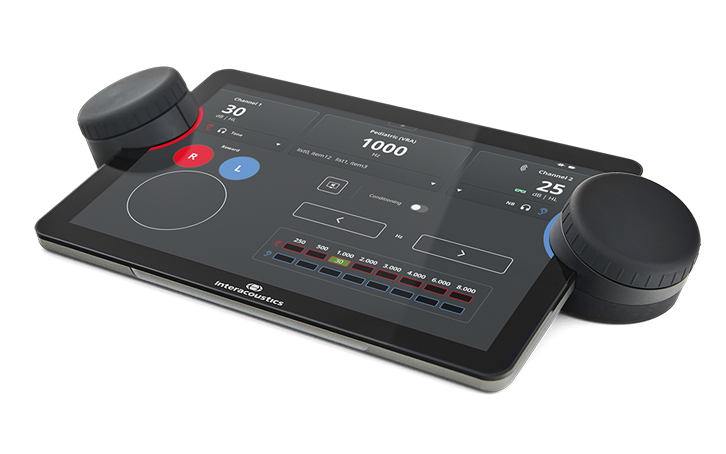
The role of the second tester
The importance of the role of the second tester is often underestimated when it comes to VRA testing. Although it’s logical to see the first tester as the person leading the appointment, in fact, our second tester has a much more pivotal role when it comes to the cooperation of the child.
A happy child who is enjoying their VRA experience is one who is much more likely to produce results than an upset, scared, or nervous child. Whilst it’s not always possible to ensure we have a happy patient on our hands, there is a great deal that the second tester can contribute towards this.
Building a relationship with the child
The second tester should be in the testing room, sat in their position on the opposite side of the table before the child enters. They should have a toy or two on the table and should welcome the child into the room in a friendly, warm, and inviting manner. This way, the child has a welcoming focal point to go towards as well as those all-exciting toys.
Wearing non-medical clothing can help the child to see this experience as not threatening. While tester one takes history from the parents, tester two has an ideal opportunity to build a friendly rapport with the child. The better the rapport between the child and the second tester, the more cooperative the child is likely to be.
As it will be the second tester interacting with the child for the test itself, it’s far more important that they – rather than the first tester – build this relationship with the child. Developing this rapport has a further benefit of helping the social reinforcement from the second tester to be more meaningful to the child. If the two are both enjoying the session and it’s a shared experience, the child has every reason to remain content and engaged throughout testing for as long as possible.
Although it can be tempting for reasons of efficiency to call the second tester into the room just as the VRA test is about to begin, this can be quite risky. Introducing a new face and expecting the child to perform almost immediately can disrupt the flow and introduce a source of unknown which can feel daunting or scary to that child.
Role during testing
During testing, our second tester has much closer contact with the child than tester one. It’s this – combined with their closer rapport and better understanding of the child – that places them in the most pivotal role.
Tester one should trust and accept guidance from tester two. They will be better placed to judge when to start testing and how the child's progressing throughout testing in terms of:
- Mood
- Interest level
- Attention span
- Degree of enthusiasm and engagement
It’s important that tester two recognizes the responsibility they have to feed back to tester one and is confident in contributing to the appointment. It’s often the case that trained and experienced clinicians find this easier and more natural to do than assistants or students. Clinicians who work together on a regular basis will also find this communication easier.
Engagement vs distraction
Our understanding of child psychology can inform how the second tester plays and interacts with the child. There can be a tendency to assume that VRA is quite a complex task for the child and as clinicians, we are very aware of the importance of obtaining results and the pressure of the limited attention span of such young children.
Often, it follows that the second tester interacts minimally with the child using only very basic play to distract them. However, young babies are capable of a lot more than we often give them credit for. If the visual reinforcer is motivating enough and conditioning has been successful, then a normally developing one-year-old child is quite capable of playing with a toy and having their attention drawn away by the stimulus at the same time.
This is where the concept of engagement rather than distraction becomes relevant. Some VRA guidelines and advice will encourage the second tester to distract the child. However, the British Society of Audiology's recommended procedure for visual reinforcement audiometry has adopted the importance of engagement, advising the second tester to engage the child in play rather than distract them.
Benefits of engagement
There are several reasons why the second tester should avoid simple distraction.
1. Keep appropriate focus
If you wave a toy in front of the child without them being able to play with it themselves, the chances are that child will try to reach for the toy. The problem we have here is that that unobtainable object has now become their sole focus and they are motivated by that toy rather than the visual reinforcers and the stimulus.
Allowing the child to play with the toy themselves means that their drive and their need to have the toy have been met. Their natural curiosity about what it does, how it feels and so on can be satisfied. This allows the stimulus and visual reinforcers to remain more motivating than the toy itself.
There is a balancing act in not giving the child too interesting or too complex a toy, or too many toys. Use their age as a guide as well as the second tester’s judgment of their developmental stage. For very young infants, waving a toy in front of them may be engagement enough but you should use social interaction as appropriate to ensure that it’s engaging rather than uninteresting distraction.
2. Maintain rapport and interest
If the child plays with the second tester, this continues to be an interesting and enjoyable experience for the child and further cements that rapport that the child and the second tester have developed before testing began.
If the second tester becomes distant as soon as testing starts, this could be upsetting and confusing for the child. And if the toys aren’t interesting, they will soon grow bored of the task and the appointment. Remember, the happier the child is and the more they enjoy the experience, the more attention span and testing time you will have available.
3. Reduce checking and false positives
Employing engagement type play rather than distraction techniques is a powerful tool in reducing checking and false positives. The ongoing principle must be maintaining the correct balance of the stimulus and visual reinforcers being more motivating than the engagement toys. But not to such an extent that they hold the child's sole focus.
If the stimulus and visual reinforcers are more motivating than the engagement toys, there is a higher risk of checking and false positives. The degree to which they will be motivating will vary for each child. But if such a scenario occurs, increasing the amount of engagement with tester two and the toys can help to rebalance the child's focus attention and motivation away from the stimulus and visual reinforcers.
4. Support social reinforcement
Engagement type play can help to support social reinforcement. The need for social reinforcement to supplement the visual reinforcers will vary according to each child. However, with the joint play that comes with engagement rather than distraction also comes a greater rapport and trust between the tester and the child.
If the second tester is excited and enthusiastic about the visual reinforcers, the child will absorb and imitate this reaction. If the child trusts the second tester and sees them as a new friend, the shared experience of the VRA test will be positive and enjoyable.
Uninteresting and dull engagement will weaken this bond, meaning the social reinforcement could lack the influence and power it otherwise would have carried.
Performing VRA with one tester
It is best practice to perform VRA with two testers. One to control the audiometer and stimuli presentations, and the second tester to engage with the child during the test. There are some examples of one-tester VRA being performed.
Read more: Performing one-tester VRA
Testing technique
Below, we’ll discuss conditioning, the testing phase, and minimum response levels.
Conditioning
The starting point of VRA testing is the conditioning phase. This involves the patient learning to associate the presentation of the stimulus with the delivery of the visual reinforcer, resulting in a head turn towards the reinforcer when they hear the stimulus. This is essential for the VRA test to be successful.
You should perform conditioning at a suitable supra-threshold level. If the patient has a known hearing loss, the configuration and extent of the loss should be considered and an appropriate stimulus / level combination selected for the conditioning phase. If the patient’s hearing levels are not known, it is recommended to start at 1 kHz at a level of 65 dB HL (BSA, 2024).
The conditioning phase involves presenting the stimulus and the visual reinforcer simultaneously to help the patient associate the link between the two. Social reinforcement from tester two (pointing at the reinforcer, leading toys towards the reinforcer, or even walking over to the reinforcer) may be required to encourage the child to look towards the reinforcer and can help create a sense of enthusiasm and excitement in the testing process.
Several conditioning trials may be required before the child develops a strong association between the stimulus and reinforcer. Once the child appears to be linking the two together, you should perform two “non-conditioning” trials to confirm that the conditioning phase has been successful.
This involves presenting the same stimulus / level as during conditioning, but without presenting the visual reinforcer at the same time. If the child turns their head independently (without any cues from tester two), then you should present the visual reinforcer as a reward for turning their head. You should also provide social reinforcement as encouragement.
Once two of these “non-conditioning” trials have been successful (i.e. the child turned to the stimulus independently on both occasions), then the testing phase can begin. If the child does not turn independently, then conditioning has not been established and should be continued for further attempts until successful.
Testing phase
Once it has been established that conditioning has been successful, the testing phase can begin by presenting the next stimulus presentation at a quieter level. Typically, a 20 dB down / 10 dB up approach is recommended for VRA due to the potentially limited attention span of the target age group.
For example, if 65 dB was presented at 1 kHz for conditioning, the next stimulus presentation would be 45 dB at 1 kHz. If a positive head turn was elicited at this level, then a further drop of 20 dB down to 25 dB would be the next step.
If no response is elicited to a particular level, the clinician should increase the next stimulus presentation level by 10 dB. It may be useful to focus in on 5-dB steps around threshold (particularly for hearing aid prescription purposes). However, use caution when judging whether this is appropriate in the wider context of the assessment.
It may be more suitable to obtain a breadth of testing (e.g. more frequencies, both ears, more transducers) than to focus on small steps at one stimulus as the patient’s attention span may be limited and hard to regain once lost.
The frequencies that should be tested (and the order of testing) should be determined based on the clinical question that relates to each individual patient. Clinicians should be aware of any minimum requirements for discharge criteria (the frequencies required to be tested and to which minimum level to confirm satisfactory hearing and no further assessments). This is typically specified at national level or by each individual hospital / clinic.
If you detect raised hearing levels via air conduction (sound field or ear specific), then bone conduction testing is required to establish the nature of the hearing loss. Tympanometry measurements are not sufficient to confirm a conductive loss. You should establish cochlear function via bone conduction audiometry. If there is bilaterally raised hearing on air conduction, then masked bone conduction is required to confirm the nature of the hearing loss in each ear.
Ear-specific testing via transducers and bone conduction (with or without masking) may not be well tolerated by some patients. Gentle encouragement, distraction with other toys, demonstrating on oneself, or pretending with the patient’s parent/carer may help to alleviate any initial anxieties or fears the patient may have. However, there are many cases where you must perform testing across several assessments to build a full audiogram.
Minimum response levels
The British Society of Audiology defines the criterion for a minimum response level as the lowest level at which a response occurs in at least two out of three ascending trials. That is: greater than fifty percent of the time.
In determining whether a response has been given, it’s important to be aware of false positives or checking. A false positive response occurs when the child checks to look for the visual reinforcer regardless of sound stimulus presentation.
If a checking response coincides with the presentation of the stimulus, it can be mistaken for a true positive response. You can use ‘no‑sound’ trials to find out to what extent the child is checking and an increase in the level of engagement with the second tester can help to reduce the amount of checking.
Recording responses: Using VRA ticksheets
A VRA ticksheet is a paper or electronic form which is used to record the responses (head turns), or non-responses (no head turn) of the patient to the presented stimuli. Ticks are used to indicate a response was elicited. Crosses are used to indicate that the patient did not respond.
The use of ticksheets in VRA testing is recommended by the British Society of Audiology and is considered best practice for this method of audiometry. VRA responses are accepted in the form of conditioned head turns, time locked to stimuli presentation.
However, such responses can be variable from one patient to another and are inherently subjective in nature, as is the clinician’s interpretation of such head turns. Ensuring the child is effectively engaged in playing with toys can help to improve certainty in the interpretation of a response.
By recording each response or non-response to the stimuli presented on a ticksheet, the clinician can create a record of the full assessment. There are numerous benefits to this:
- The clinician has a live record of the assessment as it takes place, which means they do not have to remember which stimuli have been presented and what the child’s responses were – it is all written down for them.
- The record of the assessment details whether the clinician’s testing strategy was appropriate, following recommended procedures and protocols (e.g. were suitable step sizes used, were repeated stimulus presentations appropriate).
- This record is then available for peer review / audit purposes.
- This record can be used as evidence of the assessment undertaken during litigation.
An example of a VRA ticksheet is shown below (Figure 7).
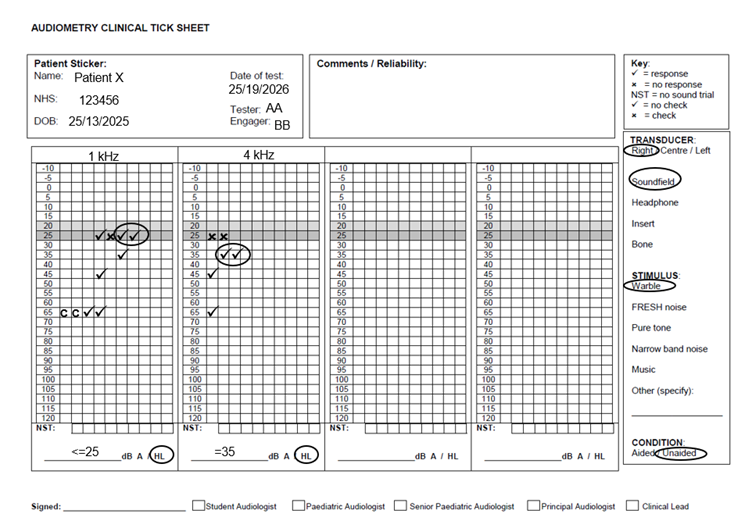
In this example, we can see that testing has been performed via the sound field speaker to the right of the patient using warble tones in the unaided condition. Testing started at 1 kHz with two conditioning trials (denoted by the C) at 65 dB. Two non-conditioning trials were then presented with positive responses, which confirmed successful conditioning, allowing the testing phase to begin.
For this ticksheet, descending presentations are recorded in the same column, and ascending presentations (or repeat presentations of the same level) are recorded in the adjacent column to the right.
As such, we can see that after the two presentations at 65, the next presentation was at 45, with a positive response, hence a tick. Next was a presentation at 25, also with a positive response and a tick. However, the next presentation, which was a repeat at 25 (as this was the minimum testable level), did not elicit a head turn response and therefore a cross mark was placed to denote that the child did not turn in response to this presentation.
As there was no response, an ascending presentation at 35 was performed next and a positive head turn was elicited, leading to a tick being placed in the next column over at a level of 35. Testing then descended to 25, with the positive head turn recorded with a tick in the same column.
This was then repeated with another positive head turn recorded with a tick in the next column. At this point, testing at 1 kHz was stopped as 2 out of 3 responses were obtained at 25 dB (circled and recorded at the bottom of the ticksheet as the determined minimum response level).
Testing was then continued at 4 kHz, with the ticksheet recording positive responses with a tick and non-responses with a cross, following the same ascending/descending technique as used for 1 kHz.
Formats of VRA ticksheets
There are different formats of VRA ticksheets used, including paper versions whereby the clinician must manually complete the form. You can then add this to the patient’s notes in hard copy and/or by electronic scanning.
Electronic versions are also used in different formats including Excel spreadsheets and computerized audiograms. It is important that whichever chosen format is used, the ticksheet has the capacity to be clearly read and understood by an outsider with the order of testing made obvious.
The Equinox Evo audiometer includes an integrated and automated ticksheet within the pediatric test screen. This ticksheet is populated using crosses and ticks depending on whether the visual reinforcer is presented or not. A positive head turn response from the child should involve the visual reinforcer being presented, whereas a non-response (no head turn) should not be reinforced.
The Equinox Evo ticksheet follows the methodology as described in the above example:
- Descending presentations are recorded in the same column.
- Ascending presentations are recorded in the adjacent column.
- Repeat presentations are recorded in the adjacent column.
As this ticksheet is completed automatically, the clinician does not need to manually enter the responses themselves, allowing their focus to remain directed on the patient and the testing process. You can access the ticksheet in on-top mode for reference during testing.
If you select the conditioning button within the suite or on the Touch Keyboard, a C will be placed in the ticksheet. The ticksheet algorithm will place a tick if a reinforcer is presented within 4 seconds of the onset of the stimulus, and a cross if the reinforcer is not presented or presented later than 4 seconds of the stimulus onset.
There is evidence in the literature that true responses are most likely to occur within this time window (Primus, 1992). However, it is possible to change the time window within the software settings if a longer acceptance period is required. You can make corrections by right-clicking on an individual entry and changing the entered mark. The completed ticksheet is saved alongside the stored audiogram for future reference.
The Equinox Evo ticksheet shown below is a direct copy of the manual ticksheet shown above, to provide a comparison between the two (Figure 8).
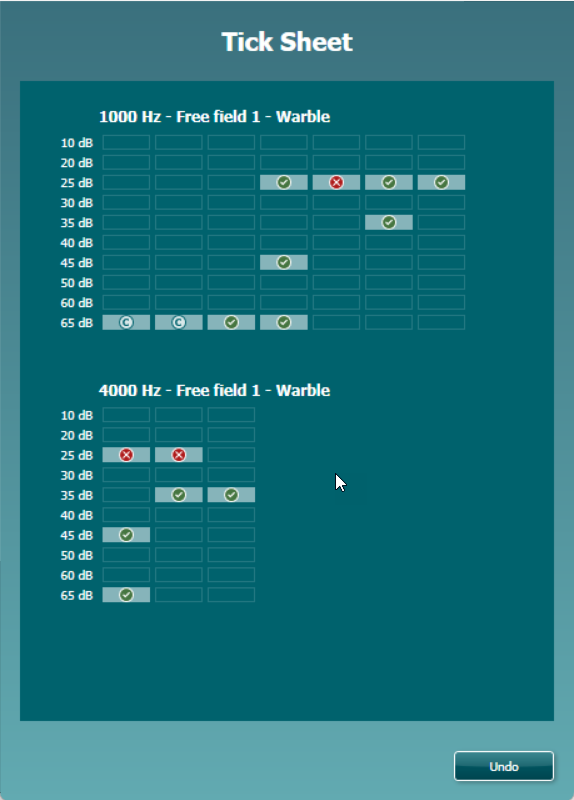
How to avoid pitfalls in VRA testing
Performing good quality VRA can be a complex task and it’s important to be aware of possible pitfalls and sources of error. The British Society of Audiology's recommended procedure has highlighted the most common of these pitfalls, and we'll take a look at how we can address some of these below.
Pitfall 1: Inadequate test setup and communication
The first pitfall listed in the BSA-recommended procedure is inadequate test setup and communication between testers. To address this, review this video on VRA preparation and assess your VRA testing room and environment with a critical eye to see if you can make any improvements.
One of the best investments you can make is providing a two-way communication system for your testers. It's also worth discussing the roles of the testers as a clinical team to ensure everybody knows and is aware of their responsibilities and all team members feel confident fulfilling their roles.
Pitfall 2: Conditioning to sub-threshold stimuli
It can be easy to attempt to condition to sub-threshold stimuli if the child's hearing levels are unknown. To select an appropriate conditioning level, investigate the patient’s case history and any other test results including previous hearing levels if available.
If conditioning is not working, trying vibrotactile stimulation can help to establish whether you can condition the patient to this type of task using a non-auditory stimulus. This can show that they couldn't hear the auditory stimulus, or they are not ready for this type of task.
Using insert earphones or headphones offers the option of going louder than is safe in the sound field. But be careful not to present at uncomfortably loud levels.
Before progressing with testing, always confirm that you have conditioned the child by checking for those two independent head‑turn responses.
Pitfall 3: Incorrect scoring as true responses
Accepting a movement other than a clear head turn or accepting a checking response is one of the most problematic errors made in VRA testing. It’s important to focus on that clearly defined head‑turn response and for the testers to be confident in what that head‑turn response looks like for an individual child. Being able to differentiate between that and a checking response, which is often much faster and briefer, is crucial.
Using ‘no‑sound’ trials throughout testing can help to identify checking responses.
Reading the child and the testing scenario allows for the best timing of stimulus presentation.
It’s also important to avoid introducing tester response bias. If the tester believes or wishes that the child's hearing is normal, then this can lead to a lack of objective interpretation. We should never assume normal hearing or try to prove normal hearing. Our role is to assess and record results whatever they may be.
Pitfall 4: Response cues given to the patient
The second tester must be aware of how they play and interact with the child. Phasing their attention to a slow or a complete stop at the same time as the stimulus presentation occurs risks cueing the child and recording a false positive response.
Maintaining appropriate engagement throughout testing is essential.
The second tester must ignore the stimulus presentation and keep up their play. The head‑turn response of an engaged child is a reliable response.
The child’s parents also risk providing cues. So you should instruct them appropriately and both testers should remain alert to any potential cues.
Pitfall 5: Overemphasis on quantity
It’s understandable to want to get as many results as possible in each session. However, testing one or two frequencies reliably is worth much more than rushing through four or more frequencies with questionable reliability. It’s always worth investing time in correct, effective conditioning at the start of the session rather than hurrying down to quieter levels.
VRA requires patience and if you present stimuli rhythmically, then the child's responses can also become rhythmic. Varying stimulus presentation timing and using a healthy number of ‘no‑sound’ trials will add to the reliability of the test.
Once again, we should never assume normal hearing or be hoping to record normal hearing.
Results interpretation
Below, we’ll discuss minimum response levels, correction factors, and ear specificity.
Minimum response levels
When performing VRA, it is commonly thought of as a threshold test, similar to other types of audiometry. However, it has been established that the responses derived from children performing VRA are generally not at as low a level as can be established from an adult.
Therefore, the more appropriate terminology for VRA is to use the term minimum response level. The minimum response level is the lowest intensity level at which reliable repeatable responses are obtained (i.e. positive head turn responses in more than 50% of presentations) for a given sound stimulus.
There are several factors which lead to this difference between infant VRA minimum response levels and adult thresholds. These include both sensory and non-sensory factors (including ear canal size) and other elements such as the noise generated by the patient themselves. These elements can combine and thus require the stimulus presentation levels to be raised to elicit a response from an infant compared with adults (Nozza, 1995; Nozza and Henson, 1999).
Correction factors
It has been estimated that normally hearing infants (those children under 12 months of age) have mean thresholds at approximately 10 dB greater than adult thresholds (across the range of 0.5 to 4 kHz) when tested using VRA in the sound field. However, there is very limited evidence for this widely accepted value.
What this means is that an infant with a minimum response level at 45 dB HL could be considered to have equivalent hearing to an adult responding at 35 dB HL. Therefore, it is suggested that when testing infants by VRA in the sound field, you should test hearing levels down to at least 25 dB HL, as this would be equivalent to adult hearing levels of 15 dB HL and therefore well within the normal range.
Testing to 25 dB HL, rather than 30 dB HL, allows for uncertainty regarding the 10 dB value and ensures that the minimum response level is within the range of normal hearing thresholds, rather than at the limit of normal. Such guidance should not discourage testing down to lower levels, ambient noise permitting (BSA, 2024).
There are studies which have explored correction factors for insert earphone VRA testing. It is important to highlight that these values have only been established on normally hearing children under the age of 12 months. The published values are summarized in the table below.
| Study | Frequency | Mean minimum response level | Recommended correction value |
| Nozza (1995) | 500 Hz | 15 dB HL | |
| Nozza and Henson (1999) | 500 Hz | 17.2 dB HL | 15 dB HL |
| Parry et al. (2002) | 500 Hz | 16.4 dB HL | 15 dB HL |
| Nozza (1995) | 1000 Hz | 14.1 dB HL | 15 dB HL |
| Nozza and Henson (1999) | 1000 Hz | 15 dB HL | |
| Parry et al. (2002) | 1000 Hz | 13.3 dB HL | 15 dB HL |
| Nozza (1995) | 2000 Hz | 5 dB HL | |
| Nozza and Henson (1999) | 2000 Hz | 6.8 dB HL | 5 dB HL |
| Parry et al. (2002) | 2000 Hz | 7.1 dB HL | 5 dB HL |
| Nozza (1995) | 4000 Hz | 5 dB HL | |
| Nozza and Henson (1999) | 4000 Hz | 5 dB HL | |
| Parry et al. (2002) | 4000 Hz | 6.4 dB HL | 5 dB HL |
Table 1: Comparison of minimum response levels in infants for insert earphone VRA studies in children with normal hearing.
You can subtract these values from the minimum response levels recorded via VRA to provide an approximation to adult hearing levels.
No studies have been identified that provide reliable correction factors between bone conduction VRA minimum response levels and sound field thresholds in dB HL. In view of this, it is important to label results appropriately where BC minimum response levels are presented alongside corrected AC minimum response levels (BSA, 2024).
Ear specificity
When testing in either the sound field or via bone conduction, it is important to be aware that any responses provided by the patient to the stimulus presented are not representative of ear-specific information.
Although the sound field speaker(s) may be located on either side of the child, and typically the conditioning process involves encouraging a head turn response towards the visual reinforcer located nearest to the speaker, the stimuli presented from any speaker in any location within the testing room is able to reach either or both ears.
You should not interpret the direction of head turns as evidence of responses being generated by the corresponding ear. Interpret sound-field-testing results with the understanding that the responses correlate to the better ear, if there is one.
Make no inferences about which ear this may be or any possible asymmetry. Ear-specific testing via headphones or insert earphones is required to establish hearing levels for each individual ear.
With bone conduction testing, similar principles apply as with sound field testing and as with other audiometry such as pure tone audiometry. Bone conduction generated responses correspond to the better ear cochlea, if there is one. The application of masking noise to the non-test ear is required to establish hearing levels for each individual cochlea.
Aided VRA testing
VRA in the aided condition (i.e. with the patient wearing their hearing aids in situ and switched on) is a valuable addition to the test battery as it can provide important information about how well the patient is able to hear via their hearing aids.
This is a form of validation, which confirms whether the hearing aid fitting is appropriate (or not, which can then lead to adjustments or changes to the patient’s amplification). This is a particularly important step in the patient pathway for young children, as they are at a crucial age for speech and language development.
If they are not receiving the appropriate amplification, they may not be able to access the important speech sounds around them that are vital for them to hear to develop their own speech and language skills.
Stimuli for aided VRA testing
It is a common misconception that you can perform aided testing in the same way as you perform unaided audiometry, using warble tones. This is sometimes called ‘functional gain testing’ as it allows for a direct comparison of the aided vs unaided testing condition using the same stimuli.
However, the use of functional gain assessments is not recommended by the British Society of Audiology (2024). Instead, it is preferable to perform aided testing using speech-like stimuli as they provide several benefits:
- Hearing aids are primarily designed to improve the audibility of speech.
- Hearing aid verification such as REM or RECD use the ISTS signal, which is representative of the long term average speech spectrum.
- With young children, the main clinical question is generally focused on whether they can access speech sounds sufficiently to support their speech and language development.
- If a direct comparison of the two conditions is required, these stimuli can be tested unaided as well as aided.
There is a range of speech-like stimuli available for aided (and unaided) VRA testing. The Equinox Evo audiometer includes the following frequency-filtered sounds for such a purpose:
- HD-Sounds
- LING-6 sounds
- ManU-IRU stimuli
The LING-6 sounds have been well established for some time (Scollie et al, 2012; Glista et al, 2014). The ManU-IRU stimuli (Stone et al, 2019) were developed for aided cortical testing (available on the Interacoustics Eclipse) but were validated via different types of hearing aids in both a cortical setup and a VRA setup.
These stimuli were further used for VRA testing by Visram et al. (2023) during a large-scale study of over 100 infant hearing aid wearers.
Aided VRA testing for cochlear implants
You can also use VRA in the ‘aided’ condition for patients who have been implanted with cochlear implants or other implantable devices. In addition to the traditional two-speaker VRA setup, the Equinox Evo offers a FreeField+ option whereby you can use a four-speaker VRA setup to perform more advanced VRA testing, incorporating ‘speech-in-noise’ testing conditions.
References
British Society of Audiology. (2024). Practice guidance: The acoustics of sound field audiometry in clinical audiological applications. Retrieved February 27, 2025.
British Society of Audiology. (2024). Recommended procedure: Visual reinforcement audiometry. Retrieved February 25, 2025.
Glista, D., Scollie, S., Moodie, S., Easwar, V., & Network of Pediatric Audiologists of Canada (2014). The Ling 6(HL) test: typical pediatric performance data and clinical use evaluation.
Parry, G., Hacking, C., Bamford, J., & Day, J. (2003). Minimal response levels for visual reinforcement audiometry in infants. International journal of audiology, 42(7), 413–417.
Primus M. A. (1992). Operant response in infants as a function of time interval following signal onset. Journal of speech and hearing research, 35(6), 1422–1425.
Nozza, R. J. (1995). Estimating the contribution of non-sensory factors to infant-adult differences in behavioral thresholds. Hearing Research, 91(1–2), 72-84.
Nozza, R. J., & Henson, A. M. (1999). Unmasked thresholds and minimum masking in infants and adults: separating sensory from nonsensory contributions to infant-adult differences in behavioral thresholds. Ear and hearing, 20(6), 483–496.
Scollie, S., Glista, D., Tenhaaf, J., Dunn, A., Malandrino, A., Keene, K., & Folkeard, P. (2012). Stimuli and normative data for detection of Ling-6 sounds in hearing level. American journal of audiology, 21(2), 232–241.
Stone, M. A., Visram, A., Harte, J. M., & Munro, K. J. (2019). A Set of Time-and-Frequency-Localized Short-Duration Speech-Like Stimuli for Assessing Hearing-Aid Performance via Cortical Auditory-Evoked Potentials. Trends in hearing, 23, 2331216519885568.
Visram, A. S., Stone, M. A., Purdy, S. C., Bell, S. L., Brooks, J., Bruce, I. A., Chesnaye, M. A., Dillon, H., Harte, J. M., Hudson, C. L., Laugesen, S., Morgan, R. E., O'Driscoll, M., Roberts, S. A., Roughley, A. J., Simpson, D., & Munro, K. J. (2023). Aided cortical auditory evoked potentials in infants with frequency-specific synthetic speech stimuli: Sensitivity, repeatability, and feasibility. Ear and Hearing, 44(5), 1157-1172.
Presenter

Get priority access to training
Sign up to the Interacoustics Academy newsletter to be the first to hear about our latest updates and get priority access to our online events.
By signing up, I accept to receive newsletter e-mails from Interacoustics. I can withdraw my consent at any time by using the ‘unsubscribe’-function included in each e-mail.
Click here and read our privacy notice, if you want to know more about how we treat and protect your personal data.
